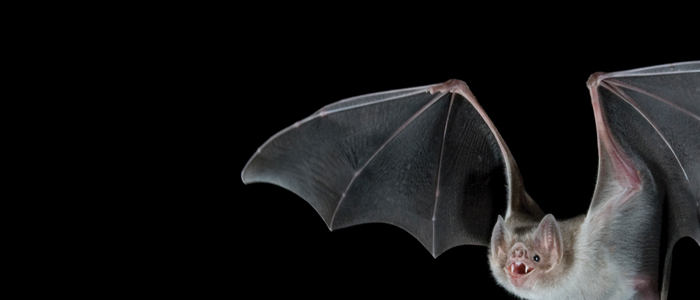In our blood

By Jennifer Baird
Glasgow ecologist Daniel Streicker works from a field station in Peru to study rabies transmission in vampire bats. The bats are the main cause of human deaths from rabies between northern Mexico and northern Chile, and they also have a devastating effect on livestock and livelihoods.
The bizarre sight of a tiny flying mammal scuttling along the ground on its thumbs, intent on sinking its teeth into the ankle of an unsuspecting animal, may seem like the comical creation of a cartoonist. Vampire bats are real, however. And they present long-term problems to the health of both livestock and people in Latin America.
In parts of the Andes and Amazon of South America, the flying bloodsuckers are spreading Vampire Bat Rabies Virus (VBRV) and wreaking havoc on livestock in ever-greater numbers. The result is multi-million-dollar losses each year for subsistence farmers and an increasing health threat to humans. Unpredictable outbreaks of rabies are capable of killing dozens of people in some remote rainforest areas.
A new approach
Traditional methods of attempting to control the disease, such as culling bats by setting their caves on fire, may actually make the problem worse by encouraging the bats to roam further afield. It’s time for a new approach.
What if we could predict where and when outbreaks of rabies were likely to appear? This is the focus of Dr Streicker’s research.
“When I first started studying vampire bat rabies, I was shocked to see how many knowledge gaps existed for a disease that was so important for the health and economy of an entire continent,” he says.
“My approach has been to answer basic questions on how the disease persists in bats, and in doing so, to empower more effective decision-making by the authorities that deal with the disease on a daily basis.”
 Dr Streicker leads a team of researchers covering 30 separate sites in Peru. Coping with travel, political instability, snakes and mudslides is challenging, but his dedication is essential. The research is already yielding valuable insights.
Dr Streicker leads a team of researchers covering 30 separate sites in Peru. Coping with travel, political instability, snakes and mudslides is challenging, but his dedication is essential. The research is already yielding valuable insights.
Crossing the Andes
He has been using ingenious new analyses of molecular genetic data to predict how and where bat-borne rabies will spread. Nuclear, mitochondrial and viral genetic markers tracked how the spread of the virus is connected to bat population movements. This also revealed that males, rather than females, were largely to blame for the spread of VBRV to new areas.
Worryingly, the analysis also showed that there is new mixing of vampire bats found on either side of the Andes. This means that the VBRV-endemic regions of the Andes and Amazon are now connected to the currently rabies-free Pacific coast. This has enabled our researchers to forecast that coastal areas will see their first cases of rabies by June 2020 – a prediction which has been corroborated by the appearance of the disease in livestock living along corridors in the direction indicated by the studies.
“If rabies continues to traverse the Andes and reaches currently uninfected vampire bat populations on the Pacific coast,” says Dr Streicker, “this will have important practical implications for rabies control programmes in Peru, and potentially Ecuador and Chile.”
This could take the form of local vaccination programmes, bat control measures or education about the risk posed by vampire bats.
Predicting the future
Forewarned is forearmed, and the information from Dr Streicker’s study has the potential to help governments in the region take preventative action to manage the emergence of the disease in both animals and humans.
Investigations such as these illustrate how tightly the health of humans, animals and ecosystems are interconnected. The University’s strengths in this field of research lie in an integrated “one health” approach, which brings together experts in human and veterinary medicine, ecology and social sciences to devise solutions and reduce the spread of disease.
In Africa, we play a leading role in rabies surveillance, control and prevention. Evidence from our highly successful dog vaccination programme in Tanzania is helping to make the global aim to stop human deaths from rabies by 2030 a reality. Our researchers are also looking for new ways to tackle diseases such as Zika, malaria and African sleeping sickness.
Researchers such as Dr Streicker’s team in Peru use their expertise to help devise practical strategies to reduce the burden of disease around the world.
Dr Streicker spends much of his time in the Andes and Amazon of Peru, looking for answers that could have a real impact on people’s lives. He was named as one of National Geographic’s Emerging Explorers in 2015.
Three species of vampire bat
Learn more about the vampire bats and how they find their food
- Vampire bats are the only mammals that feed entirely on blood.
- Cattle and horses are their usual victims, but they feed on people too.
- Between 2009 and 2013, they bit 20,000 people in Peru alone.
There are three different species of vampire bat:
- The common vampire bat keeps blood flowing from its prey thanks to an anticoagulant in its saliva.
- The hairy-legged vampire bat feasts mainly on bird blood.
- The white-winged vampire bat pretends it is a baby chick to gain access to the warm underside of a mother hen, where there is a dense collection of blood vessels to choose from.
This feature was originally published in Avenue 61, the January 2017 issue of the magazine for alumni and friends of the University.

